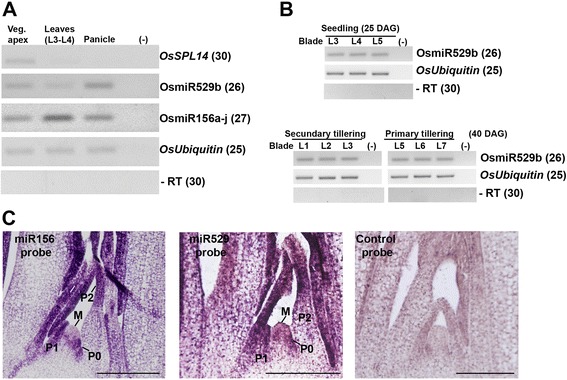Fig. 4.

Expression patterns of miR529 and miR156 in Oryza sativa. a Stem–loop pulsed RT-PCR to detect OsmiR529b, OsmiR156a-j, and OsSPL14 transcripts in vegetative apices (Veg. apex), leaf (L), and young panicle tissues. Reactions without RT (−RT) and without cDNA (−) were used as negative controls. Numbers between brackets indicate PCR cycles. DAG, days after germination. Rice Ubiquitin (LOC_Os03g0234200) was used as an internal control. b Stem–loop pulsed RT-PCR to detect OsmiR529b transcripts in leaf (L) tissues (Blade) from rice seedlings and tillering developmental stages. Reactions without RT (−RT) and without cDNA (−) were used as negative controls. Numbers between brackets indicate PCR cycles. Rice Ubiquitin (LOC_Os03g0234200) was used as an internal control. c Spatiotemporal expression patterns of miR529 and miR156 in rice shoot apical meristem (SAM). Probes of 3′-labelled LNA-modified oligonucleotides detecting miR156 and miR529 as described [38] were hybridized with longitudinal sections of the SAM from 25-DAG rice seedlings. A scramble-miRNA 3′-labelled LNA probe was used as a negative control. Purple staining shows probe localization. M, meristem; P, leaf primordia. Bars: 10 μm
